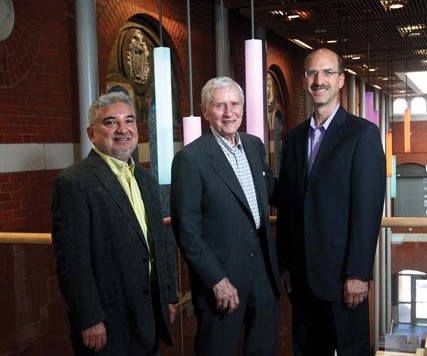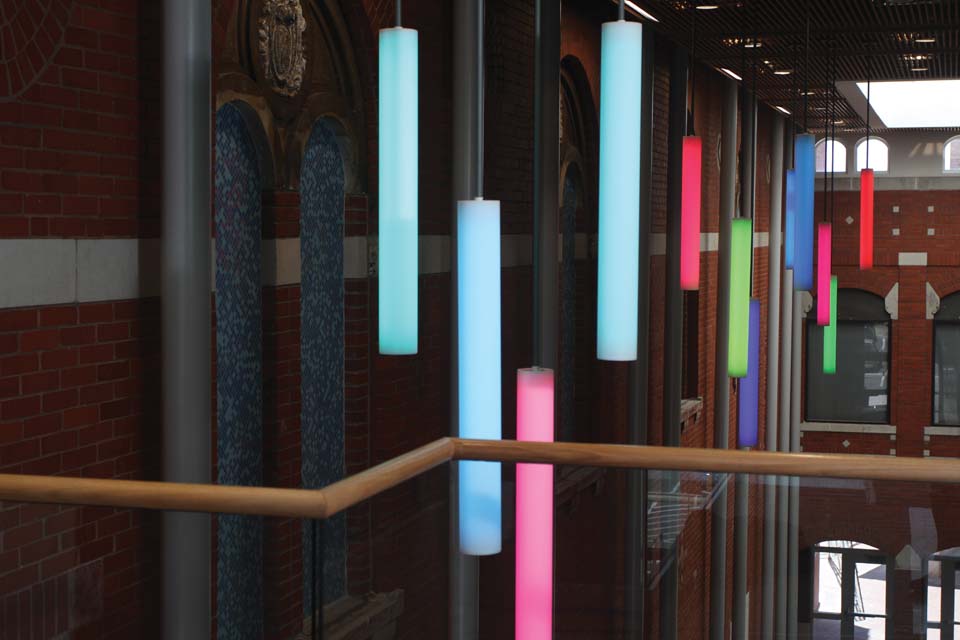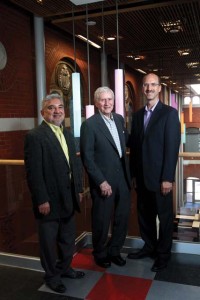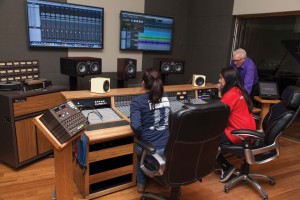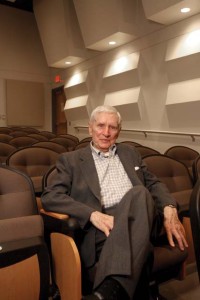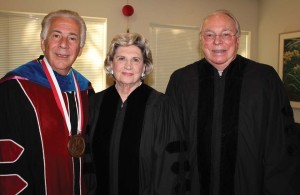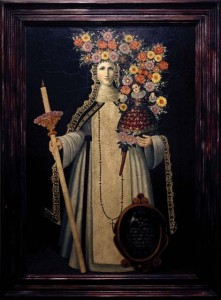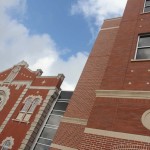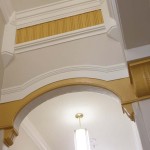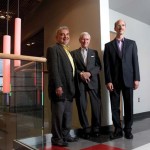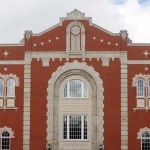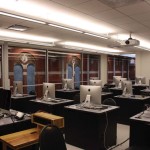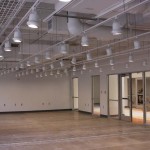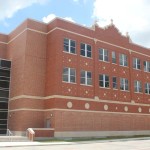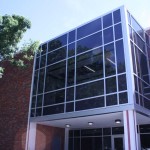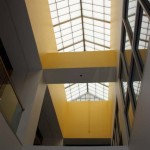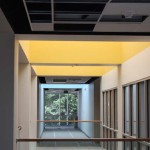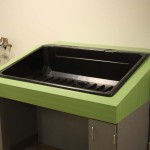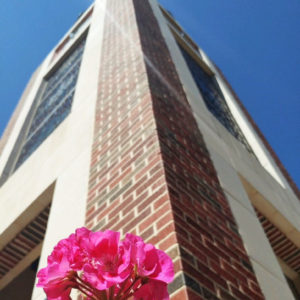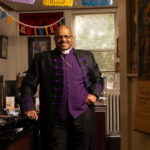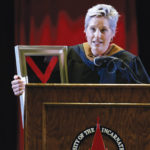By Brance Arnold ’10 MA
Renowned architect and urban planner Arthur Erickson once said, “Vitality is radiated from exceptional art and architecture.”
The University of the Incarnate Word’s (UIW) new Fine Arts Complex is not only exemplary of vitality in terms of brilliant architecture, but, more importantly, in providing a means of cultivating and expressing, through art, what perhaps is most vital: the soul. With the newly completed 55,000 square foot complex, students have access to the facilities and resources necessary to achieve a superlative fine arts education.
The complex, designed by McChesney/Bianco Architecture, a firm that has designed many facilities for the university, is composed of three main phases: the music building, concert hall, and art building.
Housing UIW’s Department of Music, the three-story music building features a 100-seat recital hall; choir and band rehearsal halls; a state-of-the art recording studio; a music therapy suite with a services center offering clinical sessions to the community; piano lab; iMac lab; 18 Wenger modular practice rooms; percussion studio; seven teaching studios for private lessons; two general classrooms; instrument storage facility; and a listening library.
“It enhances the student experience in every possible way,” said William Gokelman ’85 BM, professor and chair of music, who has worked with the architects and designers on the layout of the music building from the onset nearly three years ago.
“We went through several iterations of floor plans until we finally got to the existing one that met all of our needs,” he explained. “The three biggest needs were rehearsal spaces, practice rooms, and storage. We are undergoing reaccreditation right now with the National Association of Schools of Music, and with the new building we can move forward with reaccreditation.”
“For instance, the Cardinal Chorale, which is anywhere from 95 to 100 members, typically rehearsed in a classroom before,” Gokelman said. “And now they rehearse in a hall with 14 foot ceilings that lets the sound go up so they can actually hear and feel the music they make.”
Acoustics for several of the music facilities were designed by Russ Berger Design Group, a firm based in Addison, Texas, specializing in architectural, interior, and acoustic design for recording studios and broadcast facilities.
The studio is wired to the choir, band, recital, and concert hall on the first floor where audio and video are fed to the studio’s control booth. Camera angles can be adjusted and displayed on a monitor in the booth and audio recorded and mixed all from the studio, located on the third floor.
The concert hall, which seats nearly 500, has variable acoustics ranging from zero to 10 seconds of reverb via an electronic system installed throughout the hall designed to replicate natural, room sound. The mezzanine of the former Fine Arts Auditorium, now the concert hall, has been converted to a lecture hall for fine arts classes to be named in honor of Sr. Maria Goretti Zehr, CCVI.
For the newly renovated art building, Miguel Cortinas, associate professor and chair of art, who, along with Kathy Vargas, associate professor and former chair of art, worked with architects in the planning stages, said the major change was through the delegation of work spaces relative to media.
“We now have separate and designated studios for drawing, painting, printmaking, photography, and art history,” explained Cortinas. “There are three galleries that include the Kelso Gallery, Semmes Gallery and a student gallery.”
The new art building offers students updated technologies and resources including a computer lab for digital photography; two darkroom labs for photo classes; and a designated lighting studio for photography students as well as an exposure unit for photographic screen printing processes.
These renovations and updates also facilitate accreditation. “The art program has always looked forward to the revamping of our facilities in the pursuit of accreditation through the National Association of Schools of Art and Design (NASAD),” explained Cortinas. “NASAD maintains strict space and equipment needs for accreditation.”
UIW’s Fine Arts Campaign, through its benefactors, has played a key role in making the complex a reality. “When you walk through the building almost on every single door there’s a plaque honoring those who have given,” said Gokelman.
For example, the electronic keyboards in the piano lab were donated by the Alfred Flores family, who own Alamo Music. The Catherine and Francis Burzik Foundation, a charitable organization dedicated to benefiting higher education and the performing arts, awarded a grant toward the new music therapy observation room, as part of the Music Therapy Services Center. And the recital hall, named The Ingrid Seddon Recital Hall, was made possible by the generosity of Robert Seddon in honor of his wife Ingrid, celebrating her passion for music.
“It seemed to fit perfectly. And the recital hall was appropriate for what my wife had in mind. She loved music and was a singer,” said Seddon, who regularly attends rehearsals and performances at the recital hall. “It’s a beautiful facility and will be used for many great performances.”
Alex Castaneda, director of major gifts and planned giving, said Seddon’s gift, in addition, established the Ingrid Seddon Endowed Scholarship in Music for voice majors seeking a degree in music.
“It’s the first endowed scholarship of its kind and will increase the number of quality voice majors recruited to the university,” explained Castaneda.
Although funding for the art building has been a challenge, Cortinas said the generosity of benefactors such as Betty and Robert Kelso, who received honorary doctorates from the university in 2012, has had a tremendous impact. The couple made the single, largest donation toward the Fine Arts Complex in renovation of the art building.
“We feel very fortunate to have had the Kelso family’s commitment,” shared Cortinas. “It is a true indication of how much it means to them and how important sharing art is to the educational experience of our students.”
San Antonio philanthropists, the Kelsos have a long and generational connection to UIW. Betty is a trustee emerita of the board of trustees and her mother, the late Elizabeth Huth Coates, was an alumna of Incarnate Word High School and what was then Incarnate Word College. Coates made possible the theatre on campus that bears her name.
“The Kelsos’ gift established the (Bob & Betty) Kelso Art Center, as well as a permanent gallery where they will be donating their religious art,” said Sr. Kathleen Coughlin, CCVI, vice president for institutional advancement.
Additional funding was provided by a challenge grant from the J.E. and L.E. Mabee Foundation and gifts to the Fine Arts Campaign from members of the board of trustees, alumni, foundations, corporations and UIW employees.
From a student perspective, the complex appears to have already had an effect.
Arnulfo “Arnie” Hernandez, a sophomore pursing a Bachelor of Music in Music Education, said the new and expanded facility has enriched his experience as a student.
“My overall impression of this new facility is how it has accommodations for us as students to have a continued better education,” said Hernandez. “Those accommodations in each classroom allow us to better understand the concepts being taught to us in various ways.”
“True to its Mission of service, UIW’s goal for this program is to offer the best in arts education in San Antonio,” said Coughlin. “To that end, UIW has expanded its arts facilities so that its students and faculty have the essential resources with which to learn and master their art.”
A dedication of the facilities is planned for September as well as the unveiling of a mural, donated by the Russell Hill Rogers Fund for the Arts, to be placed on the front of the Kelso Art Center.
- UIW’s new Fine Arts Complex.
- Interior of the concert hall.
- Interior of the concert hall.
- Cortinas, Seddon and Gokelman.
- Concert Hall.
- iMac Lab.
- Piano Lab.
- One of three galleries in the Kelso Art Center.
- Lights in the music building.
- Music Building.
- The Kelso Art Center.
- Interior of the art building.
- Interior of the art building.
- Photo processing equipment in the art building.

